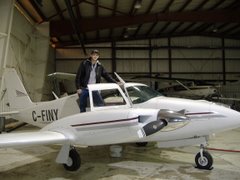The easiest way to explain flying under VFR (Visual Flight Rules) is flying in good weather. While this a good generalization, its not really the whole truth. VFR flights CAN be completed safely and legally in some pretty crappy weather conditions. The legal VFR minimums while not exceedingly simple, are very well defined. VFR weather minima are broken into different categories and sub categories, and are different for each one. Here they are as follows:
Within Controlled Airspace (Such as within the 5 mile radius designated around many airports)
Visibility 3 miles
Aircraft must be operated a minimum of 500 ft agl, and must remain 500 ft vertically, and 1 mile horizontally from cloud.
Within Uncontrolled Airspace
At Or Above 1000 ft AGL aircraft must remain 500 ft vertically and 2000 ft horizontally from cloud.
Vis during Day - 1 mile
Vis at Night - 3 miles
Below 1000 ft AGL aircraft must simply remain clear of cloud.
Vis during Day - 2 miles
Vis at Night - 3 miles
As you can see, weather minimum in controlled airspace is for the most part stricter then it is in uncontrolled airspace. This could potentially be problematic and restricting if the weather actually is poorer then the controlled airspace minima permits, however we have a nifty little tool available to solve this. Its called Special VFR. Pilots can request Special VFR to air traffic control, and the weather minima for aircraft operating under special VFR is reduced to 1000 ft ceilings, and visibility of 1 mile. This is certainly not good weather! Special VFR can be authorized for both taking off and landing during daylight, but only for landing during nighttime. If we were to visualize these conditions during the day, imagine us sitting at the end of an average length runway of 5000 ft, ready to take off. 1 mile visibility is 5280 ft, therefore we would just barely be able to see the end of the runway. Any traffic ahead would be flying half as high as they usually do in the circuit, at only 500 ft above ground.
The question that may be asked now, is this actually safe? Well, that can still depend on the weather. Other weather considerations need to be considered outside of the defined minimums also. In the winter time, we need to be more aware of icing conditions, but for the most part, that only occurs in cloud, so since VFR flying needs to be clear of cloud, it doesn't really come into place. Thunderstorms in the summer are the bane of small aircraft pilots. Thunderstorms bring severe turbulence, heavy downdrafts, hail, and lightning. All of these can be deadly. Heavy rain resulting in IFR conditions can also be a concern. The good thing about thunderstorms, is unless they are associated with a massive front moving across the country, they generally come and go quickly, so its possible to wait them out or, depending on the size of the storm and speed of the aircraft, we can fly around them.
There are loads of weather data, reports, forecasts, and charts available to pilots. There is weather reporting equipment at nearly every medium-large airport to give us hourly reports on visibility, ceiling, winds, temperature, dewpoint, and atmospheric pressure. We also have graphic charts to depic icing conditions, turbulence, clouds, weather fronts, atmospheric pressure, and winds. There is also weather radar charts and satallite images. These are all available online. We can use these charts to gain an intimate knowledge of the weather of that day, and draw our own conclusions as to what its doing. There is also a system in place to allow pilots to report actual weather conditions they have encountered, so pilots on the ground can get a first-hand report. We also have the option to phone the Flight Information Centre (we have one located in London, that serves nearly all of Ontario). The Flight Service Specialists there are available to brief pilots on the weather conditions if we are unable to access the charts. Their expert opinion can be invaluable.
All these resources can be used to make an informed go-no-go decision, and rarely to we have to depart without having a very good idea of what we are going to encounter. It is impossible to simply define what is go weather, and what is no-go weather, but VFR flights really can be completed safely in some relatively poor conditions. It just requires more attention, planning and good judgement from the pilot.
Subscribe to:
Post Comments (Atom)




thanks for this post dude.
ReplyDeleteI am studying for the PPL. I just read a TAF and METAR for a local airport to see the weather for tomorrow. I couldn't remember what the minimum visibility is for VFR and your blog answered that.
Thanks.